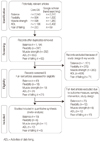1. American Geriatrics Society, British Geriatrics Society. American Academy of Orthopaedic Surgeons Panel on Falls Prevention. Guideline for the prevention of falls in older persons. J Am Geriatr Soc. 2001; 49(5):664–672.
2. Borenstein M, Hedges LV, Higgins JPT, Rothstein HR. Introduction to meta-analysis. Chichester, WS: Wiley;2009.
3. Carter ND, Kannus P, Khan KM. Exercise in the prevention of falls in older people: A systematic literature review examining the rationale and the evidence. Sports Med. 2001; 31(6):427–438.
4. Choi JH, Lee EO, Lee HY, Eun Y. Analysis of the effects of Tai Chi on muscle strength and flexibility. J Rheumatol Health. 2005; 12(1):69–80.
5. Cohen J. Statistical power analysis for the behavioral sciences. New York, NY: Academic Press;1977.
6. Erim Z, Beg MF, Burke DT, de Luca CJ. Effects of aging on motor-unit control properties. J Neurophysiol. 1999; 82(5):2081–2091.
7. Fransen M, Nairn L, Winstanley J, Lam P, Edmonds J. Physical activity for osteoarthritis management: A randomized controlled clinical trial evaluating hydrotherapy or Tai Chi classes. Arthritis Rheum. 2007; 57(3):407–414.
http://dx.doi.org/10.1002/art.22621.
8. Gillespie LD, Robertson MC, Gillespie WJ, Sherrington C, Gates S, Clemson LM, et al. Interventions for preventing falls in older people living in the community. Cochrane Database Syst Rev. 2012; 9:CD007146.
http://dx.doi.org/10.1002/14651858.CD007146.pub3.
9. Glass GV. Primary, secondary, and meta-analysis of research. Educ Res. 1976; 5(10):3–8.
10. Harling A, Sompson JP. A systematic review to determine the effectiveness of Tai Chi in reducing falls and fear of falling in older adults. Phys Ther Rev. 2008; 13(4):237–248.
12. Higgins JPT, Green S. Cochrane handbook for systematic reviews of interventions: Cochrane book series. Chichester, WS: John Wiley & Sons Ltd;2008.
13. Lam P. A handbook for Tai Chi for arthritis. Narwee: East Acton Publishing;2000.
14. Lee YJ. The effects of Tai Chi exercise program using transtheoretical model applied to degressive arthritis patients. Seoul: Hanyang University;2008. Unpublished doctoral dissertation.
15. Liu B, Liu ZH, Zhu HE, Mo JC, Cheng DH. Effects of tai chi on lower-limb myodynamia in the elderly people: A meta-analysis. J Tradit Chin Med. 2011; 31(2):141–146.
16. Logghe IH, Verhagen AP, Rademaker AC, Bierma-Zeinstra SM, van Rossum E, Faber MJ, et al. The effects of Tai Chi on fall prevention, fear of falling and balance in older people: A meta-analysis. Prev Med. 2010; 51(3-4):222–227.
http://dx.doi.org/10.1016/j.ypmed.2010.06.003.
18. Menz HB, Morris ME, Lord SR. Foot and ankle risk factors for falls in older people: A prospective study. J Gerontol A Biol Sci Med Sci. 2006; 61(8):866–870.
20. Orwin RG. A fail-safe N for effect size in meta-analysis. J Educ Stat. 1983; 8(2):157–159.
21. Rand D, Miller WC, Yiu J, Eng JJ. Interventions for addressing low balance confidence in older adults: A systematic review and meta-analysis. Age Ageing. 2011; 40(3):297–306.
http://dx.doi.org/10.1093/ageing/afr037.
22. Rothstein HR, Sutton AJ, Borenstein M. Publication bias in meta-analysis, prevention, assessment and adjustments. New York, NY: John Wiley and Sons Ltd;2005.
23. Scheffer AC, Schuurmans MJ, van Dijk N, van der Hooft T, de Rooij SE. Fear of falling: Measurement strategy, prevalence, risk factors and consequences among older persons. Age Ageing. 2008; 37(1):19–24.
http://dx.doi.org/10.1093/ageing/afm169.
25. Song R, Lee EO, Lam P, Bae SC. Effects of tai chi exercise on pain, balance, muscle strength, and perceived difficulties in physical functioning in older women with osteoarthritis: A randomized clinical trial. J Rheumatol. 2003; 30(9):2039–2044.
26. Stump TE, Clark DO, Johnson RJ, Wolinsky FD. The structure of health status among Hispanic, African American, and white older adults. J Gerontol B Psychol Sci Soc Sci. 1997; 52(Spec No):49–60.
27. Sutton AJ, Duval SJ, Tweedie RL, Abrams KR, Jones DR. Empirical assessment of effect of publication bias on meta-analyses. BMJ. 2000; 320(7249):1574–1577.
28. Tideiksaar R. Falls in older people: Prevention and management. 3rd ed. Baltimore, MD: Health Professions Press;2002.
29. Wooton AC. An integrative review of Tai Chi research: An alternative form of physical activity to improve balance and prevent falls in older adults. Orthop Nurs. 2010; 29(2):108–116. quiz 117-108.
http://dx.doi.org/10.1097/NOR.0b013e3181d243b3.





 PDF
PDF ePub
ePub Citation
Citation Print
Print





 XML Download
XML Download